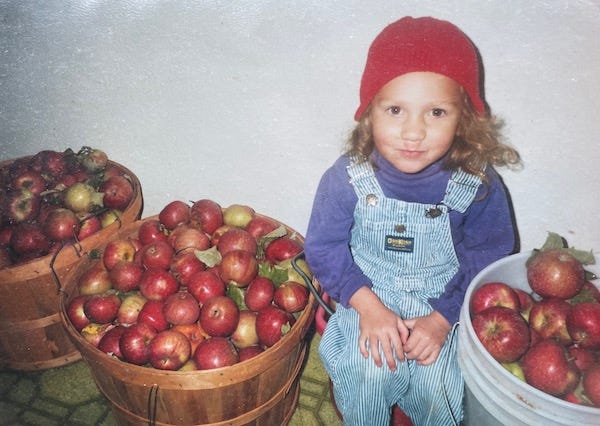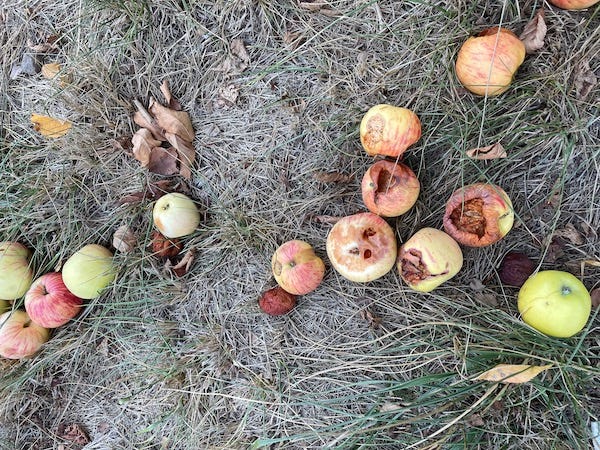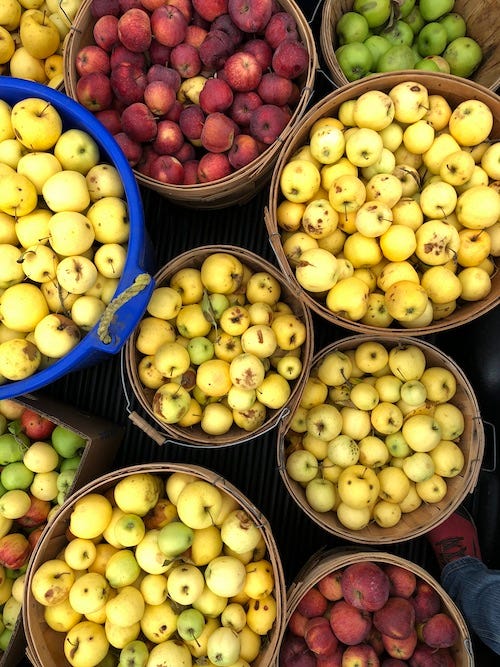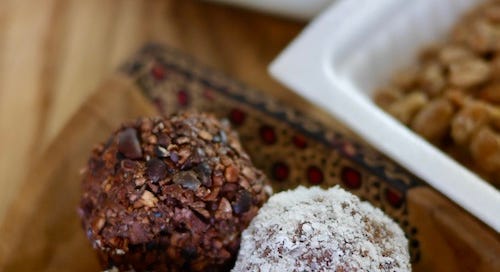N is for No Harvest (from my garden) and Natto
A little check-in from the home front. Plus...Eat natto and other Bacillus subtilis ferments: Your ♥️ will thank you!
Happy September!
It is a strange thing—time. I know I am not the first human who to marvel at how days can feel slow and long and years flash by in Happy September!
It is a strange thing--time. I know I am not the first human who has marveled at how days can feel slow and long while seasons and years flash by in an instant. The end of summer always feels like a time of rebirth for me. I admit this is weird, but as we cool off and tuck back indoors I feel invigorated. This is the time that sentimental thoughts and ghosts of seasons past also make the most appearances.
In bygone summers this was the busiest time in our kitchen. Large gardens and my obsession with food preservation coalesced into frenzied activity in which the kitchen and I hardly slept. Baskets of pears, plums, and apples lined the walls. Shallow boxes of tomatoes and buckets of peppers took up counter space and spilled over onto tables and floors throughout the house. As the season progressed the fruit flies multiplied.
Peeling, plucking, dicing, or slicing left the index finger and thumb of my right hand stained deeply from late August through late October. This year there is no staining, and my hands aren’t dry and cracking from the work. This is the first year in the last 25 that I have had no vegetable garden at all—a combination of the timing of my travel and low water. As with most relationships, I realize this relationship with a garden is also complicated. I miss it terribly and I don’t.
We still have fruit trees and way more fruit than I can preserve. The abundance this year is so much as to be overwhelming and therefore harder to know where to begin. It is ironic that I have come to embrace whole utilization (some call this zero-waste) in my cooking habits and am locked up when it comes to figuring out where to start with all the fruit.
So, I find myself preserving just enough. Six pints of plum butter will be more than enough for the two of us. Some of the pears will become dried pears, a few will land in kimchi, but most will fall to the ground to feed the wild turkeys and deer, who need to eat also. The bulk of the apples will still become cider and vinegar but I am a bit behind this year.


I remember those years when I was a young, barely 30-something, energetic mama in this narrow valley, and all the 50-something ladies were delighted to give me their mason jars for canning. They unapologetically said the lust for such things was no longer there. You go girl, they said, and do you want to pick all my grapes while you are at it?
I marveled. How could that happen? I did not see a future where I was not obsessed with food preservation. This year, I thought for the first time. I wonder if I should find a home for some of these mason jars. I laughed out loud to myself. Now, I get these ladies. Honestly, without a constant need to fill the bellies of my children who were as voracious as tiny birds with good food, I do not have the same drive. Or, maybe if I look deeper and am honest with myself, I am just a little tired of putting by.


This is what is on my mind these days and what I have been journaling about in the cool dawn mornings. I admit to no clever segue to natto but in this theme of the alphabet, I am at N and have had many requests to write about these sticky beans. And anyone who knows me will tell you I light up with this topic.
A few months ago, I wrote about vitamin K and mentioned a heart surgeon who came to two of our classes on soy fermentation in 2019 in Ohio. He came because he believed in natto. He explained to our wide-eyed class that when he “saws through a sternum” he can tell immediately what shape the patient’s cardiovascular system is in because if their bones feel brittle then he knows to be careful when clamping their veins. Because the calcium from the bones will be in the veins. He said that it “feels like there are pieces of eggshells” floating inside with the blood. This visceral description got everyone’s attention and has stayed with me. This is a double win as keeping that calcium in your 🦴bones 🦴 is also a benefit of natto. Studies also show it can stop osteoporosis in its tracks which I will explore more in the next post.
Evidence suggests that eating natto (or other B.subtilis soy ferments) can be one of the best heart-healthy diet choices one can make. A massive study released in 2019 looked at the consumption of soy and fermented soy and found a higher intake of soy was associated with lower early mortality. This study was mentioned in the New York Times in 2020 with a small summarizing article titled, Eat Natto, Live Longer? that singled out natto as the most significant factor in lowering your risk of cardiovascular disease. The remarkable part of the study is that while fermented soy, in general, has been linked to better cardiovascular health, natto came out at the front of the pack in protecting our heart health.
The study looked at mortality rates of nearly 93,000 Japanese men and women over a 15-year period. The study’s researchers decided in advance what they would measure so they wouldn’t be able to selectively choose results after the study. The significant findings of the study showed people who ate more fermented soy had lower premature death rates—after adjusting for demographic, lifestyle, and dietary factors, they found this rate to be 10 -11% lower. Consumption of non-fermented soy had no effect and the effect was greatest for natto, particularly in women. Women who ate at least 1 serving of natto a week had a 19% lower death rate after adjusting for the factors mentioned above.
Before we dive into natto I want you to understand that while this study focuses on natto, which comes from Japan, very similar versions of soy fermented with B. subtilis are found all over eastern Asia, southern Asia, and up into the Himalayas, as well as in central and west Africa. These are foods like kimena from Nepal, tua nao flavor disks from Myanmar and parts of Thailand, and cheonggukjang in Korea. Each of these, when made with soy, has the benefits of being ascribed to natto.
In truth, other than the fact that these other still ferments rely on “wild caught” local B. subtilis instead of inoculation by spores created in a lab, there is very little difference between them and natto. (B. subtilis was identified and isolated in the early part of the 20th century. This changed the method of production from cooked soybeans wrapped in rice straw, the inoculant, to a product inoculated by lab-grown starters.) Warmth and time combined with beans (mostly soy) become sticky, somewhat stinky, and infinitely more digestible and healthier. We are talking about natto because it is the most well-known in the West, has been studied more, and is the easiest to source in the West.
I do have to add quickly, that many folks are making natto-style ferments with other beans. Regularly people ask if they can make natto with beans other than soy like pinto beans, black turtle beans, or whatever their favorite legume is. You can. They work for flavor and texture. However, if you are seeking the benefits described in the studies, you might want to stick to soy-based natto. I say this because soy does have such different qualities than these other types of beans. For example, without studying pinto bean B.subtilis fermentation specifically, we can’t assume they are the same.
What is it about natto?
Natto’s first superpower is just how much Vitamin K2 (MK-7) it produces. As we learned in the post about vitamin K is that it is produced by bacteria. Some species like Bacillus subtilis are just more prolific at this than others. Remember from the above that vitamin K keeps the calcium in our bones and out of our veins.
The sticky part of these ferments contains the enzyme nattokinase – a natural blood-thinning enzyme. We like to explain it as an enzyme with little scrubbers (not the scientific definition at all) cleaning out your veins by dissolving blood clots. Nattokinase is good for varicose veins, and it can lower blood pressure and reduce the risk of stroke. (You can buy nattokinase in supplement form, while it is made by fermentation, the Vit K is pulled out. I have yet to see a product that includes the K. I suspect this is because people who might benefit from this are already on blood thinning medications and cannot consume vitamin K.)
Finally, B. subtilis is an important probiotic species for our gut health. The more we learn about gut health being tied to every system in our body the more we are understanding that this is the first place of good health. It is well-established that a healthy gut affects inflammation and our immune health which are factors that affect cardiovascular health as well.
Where to Source Natto
Your local Asian markets that carry Japanese food will have natto in the freezer section. It comes in unfortunate single-serving Styrofoam packaging but is inexpensive and an easy way to test the waters. There are some small artisan makers throughout the country. Two that I can wholeheartedly recommend are NYNatto and Wanpaku (in Portland, OR). I haven’t tasted Rhapsody’s natto, but the company is reputable, and they sell online by the case, which is great if you are committed to eating it daily.
If you are truly committed to making your own. It is easy. I promise. We have a whole chapter about natto and its cousins in our book Miso, Tempeh, Natto and Other Tasty Ferments.
In fact, the next Open Kitchen event for members will focus on making and using natto. Save the date. Saturday, September 16, 2023 at 9 am Pacific Time.
When down a 🐇🕳️ one finds interesting, albeit obscure, tidbits…
Are you looking for a natto allergy? (So your mom/significant other won’t make you eat it…)
Even though soy is a common allergen when unfermented, fermented soy is different. Natto allergies exist but they are rare. Word has it that Dr. Naoko Inomato of Yokohama City University thinks that frequent stings by jellyfish can bring about a natto allergy.
Dr. Inomata studied 18 folks with a natto allergy. Twelve were surfers, two were scuba divers, and one was a professional diver. There seemed to be a correlation to time spent in the ocean. Well, it turns out jellyfish and natto have something in common they both have polyglutamic acid. The study suggested repeated stings might cause a person to later become allergic to ingesting polyglutamic acid in natto
How to enjoy Natto?
Natto is the ferment that people have very strong feelings about. Some of us love natto and some of us cannot figure out how to get it past our mouths and into our bodies. Could be the sticky stringy texture or the nutty alkaline flavor that can have notes of ammonia. I crave it but I didn’t always. Years ago, my mother told me I should eat natto. I was somewhere in my forties but still rolled my eyes befitting my adolescent self. I couldn’t do it.
Keep reading with a 7-day free trial
Subscribe to Fermenting Change to keep reading this post and get 7 days of free access to the full post archives.





